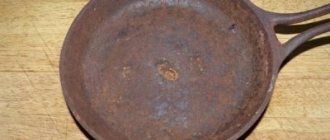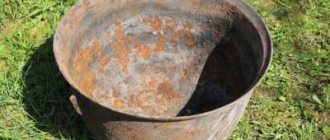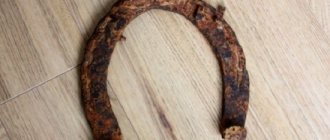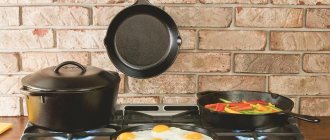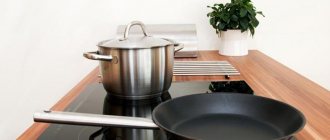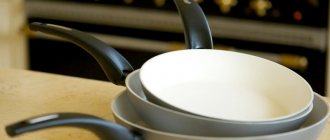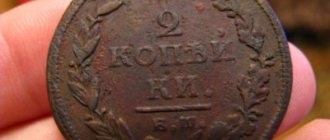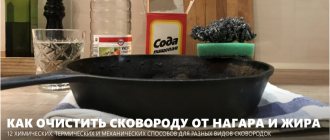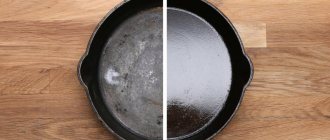Cast iron frying pans have been used for cooking since time immemorial. Modern kitchen utensils, unlike older models, are covered with a protective layer for long-term storage and convenient use. If the coating is damaged, the material may begin to oxidize, so you need to know how to remove rust from a cast iron frying pan so you can continue to use it safely. For these purposes, household chemicals or home methods are suitable - each housewife can choose the most suitable option for herself.
Causes of rust
Iron corrosion can form even on relatively new cookware. Why a cast iron frying pan rusts in this case is explained by reasons far removed from chemical processes. When storing products in warehouses of manufacturing plants, they are treated with technical oil; after cooking, it disappears, and kitchen utensils are left without protection from corrosion. And sometimes cookware manufacturers even save on the material for its manufacture, using simple iron instead of food raw materials. In this case, cast iron rusts from any dampness. In addition, even a single careless handling of the frying pan can damage the protective layer. For example, it is removed from the surface of dishes using metal brushes or strong abrasive substances used when washing.
Also, the material can rust if you do not use the frying pan for cooking for a long time. Frequent use, on the contrary, clogs the pores with oil and soot from food, which provides protection against corrosion. In addition, rust on the surface of cast iron can appear when air humidity increases. If water droplets form on the dishes, they should be placed in a drier place or a device should be installed to reduce the humidity in the room.
You should not cook in kitchen utensils that are covered with rust, as this is harmful to your health. Oxidized metal can cause food poisoning or botulism.
High humidity is one of the reasons why rust appears on a cast iron frying pan.
Cookware with traces of rust should not be used for cooking.
Features of preparation for use
[blok_2_h2]
After purchasing new cast iron cookware, you need to perform a number of steps to prepare it for use. To avoid rust, the surface should be slightly oily. To do this, it is recommended to do the following:
- First, the frying pan must be thoroughly washed. To do this, you should use soap or detergent.
- Wipe the item dry.
- Pour vegetable oil into the bottom and heat. This will help fill the pores and prevent rust. This is best done outdoors or in a well-ventilated area. The process is accompanied by a strong discharge of child.
Important: To avoid problems, you must ensure that the pan is not too dry. Its surface should always remain slightly greasy.
Before you start using a new frying pan, you should heat the product
Mechanical and thermal cleaning
The easiest way to clean a cast iron frying pan from rust is to rinse it in the dishwasher several times, wipe off the water and apply a protective layer to the surface. You can also use an oven for these purposes. You will need to clean the surface of kitchen utensils from food debris, heat the oven to 180–200 degrees or more, if the temperature allows. Next, it is required that the cast iron cookware be calcined for 30–40 minutes and become gray in color. After this, you need to let it cool, wash it with detergent, and remove all moisture. In addition, you can ignite it with salt until it turns brown, then rinse in water, wipe with a sponge and dry.
Some housewives use the digestion method, which is also suitable for cleaning kitchen utensils from corrosion:
- You need to fill the container with water so that it covers the dishes completely.
- Add 300–500 g of salt or soda to the liquid.
- Place the container on low heat and simmer for 12 hours.
- Clean the surface with a brush and cleaning agent.
You can also use 5-grit sandpaper to remove rust from a cast iron skillet. This method is recommended if there is no protective layer on the surface of the utensil and there is too much corrosion. You can also clean the dishes using a sander or a suitable drill attachment. During the process, you should be outdoors and wear protective equipment (goggles, a respirator), since the rust will fly to the sides in small pieces and also form a dust cloud.
The dishes can be baked in the oven
Cast iron is not afraid of machining
Home Remedies
TOP popular home methods:
- You can clean a cast iron frying pan from rust at home using Coca-Cola. To do this, you need to fill the container with drink so that it covers the dishes. Next, the mixture is placed on the fire and brought to a boil. After this, turn off the stove and allow the drink to cool. Dry kitchen utensils must be heated in the oven at a temperature of 150–180 degrees for 20–30 minutes.
- You can remove rust from a cast iron frying pan using a vinegar solution. To do this, you need to use a liquid with a 7–9% concentration and without dye. The mixture is diluted with water in a ratio of 1:3. Fill the container with the dishes with this mixture so that it covers the top by 2–3 cm. After this, you need to put everything on the fire and boil for 3–4 hours. If the water boils away, it needs to be topped up. You can also add detergent to the solution. After cooking, kitchen utensils must be washed to remove dirty liquid and wiped.
- If the rust on a cast iron frying pan is light in color and lies in a small layer, it can be cleaned off with baking soda. To do this, you need to mix the product with water to form a paste, apply the resulting composition to the corrosion and rub vigorously with a rag or brush (if there is no coating). After this, let the dishes stand for 10–15 minutes and rinse off the soda with water. In problem areas, the procedure can be repeated.
- You can also remove rust from a cast iron frying pan using rock salt. To do this, you need to pour the product onto the bottom of the dish. After this, place the kitchen utensils in the oven (if there are no flammable parts) or on the stove to bake for 2-3 hours. You can also make a composition of 2 tbsp. l. salt and the same amount of vinegar. You need to pour salt crystals into a frying pan and add liquid so that all problem areas are covered. After this, let the mixture boil until it evaporates. Next, it is recommended to rinse the dishes with water or scrub with a brush.
- Another homemade way to clean cast iron cookware using fish oil. You need to lubricate the entire surface of the pan with this substance and leave for 3-4 hours. Next, you need to scrub off the rust with a wire brush and wash the utensils using mild cleaning agents.
After cleaning in any way, pour 1 tbsp onto the dry surface of the dishes. l. rapeseed or sunflower oil and place it in an oven preheated to maximum temperature (at least 180 ℃). It is recommended to heat the utensils for 1 hour, then turn off the heat and leave the oven with the doors open until it cools completely.
Coca-Cola easily copes with any dirt
Many housewives prefer to clean the frying pan by heating salt on it
Special formulations
Liquids and concentrates designed to remove rust deposits contain potent substances. They provide high efficiency, but require precautions.
When handling products, you should wear rubber gloves and rinse the dishes thoroughly after cleaning.
Sanita Anti-rust
A well-known Russian brand produces a gel-like universal rust remover for metal surfaces. The concentrate contains organic acids, including oxalic acid . They account for up to 30% of all components. The amount of nonionic surfactants is less than 5%.
The gel is applied with a sponge or brush to the rust and left for 3-4 minutes to react. The maximum holding time (with a thick rusty layer) can be 10 minutes. Next, the surface is cleaned with a brush or coarse sponge and thoroughly washed in water. A 500 ml bottle is sold in stores for 85-105 rubles.
Cillit BANG
A universal product made in Russia, designed to remove rust and limescale. The gel formula contains no more than 5% nonionic surfactants. The active substance is oxalic acid.
To clean the surface, it is first moistened with water. Apply Cillit BANG to a sponge and wipe the areas covered with rust. Exposure time depends on the thickness of the plaque and ranges from one to five minutes. After this, the dishes are washed in a large volume of water. The cost of a 450 ml bottle averages 230 rubles.
Syntilor Ruggine
Liquid concentrated rust remover from a Russian manufacturer. The product is intended for cleaning metal surfaces. The composition does not contain chlorine or mercury containing substances. The rust converter is considered safe for human health and the environment and can be discharged into the public sewer system.
Before use, shake the product, dilute it with water in a ratio of 1:3 and apply it with a sponge to rusty spots . Leave the dishes for 5-8 minutes for the reaction to take place. Next, clean the surface with a stiff brush. Complete the procedure by rinsing with water. The average price for a bottle weighing 1 kg is 300 rubles.
Household chemicals
To clean cast iron from corrosion, you can also use special chemicals, for example, Pemolux or similar substances. Their properties are similar to soda or alkali. To remove rust, you need to apply the product to problem areas and wipe them with a wire brush or brush. After this, it is recommended to fill the dishes with salt to the brim and ignite them for 3-4 hours.
To clean rust from a cast iron frying pan, you can also use oven cleaner. It is used to remove carbon deposits, corrosion, soot or grease. To do this, you need to place the dishes in a bag, pour the composition into it and leave for 1 week. After this, the kitchen utensils need to be washed and dried.
The next way to clean rust from a cast iron frying pan is to use specialized corrosion removers, such as Schumanit or Milam. The composition should be applied to problem areas and left for 20 minutes (or follow the instructions on the label). After this, brush the rusty areas, rinse off the solution and dry the dishes. Due to the fact that the main component of such substances is hydrochloric acid (20% of the total mass), safety precautions should be carefully observed:
- use rubber gloves without holes or abrasions;
- do not inhale fumes from the composition;
- do not allow the substance to come into contact with exposed skin or eyes (wear glasses);
- remove all jewelry from your hands, neck or ears;
- create a draft in the room that will blow fumes outside.
You can also use substances containing chlorine, such as Sanita or Sanifor. However, it is worth remembering that after using such liquids, decorative elements or bolts that were on the surface of the frying pan will change their color and fade.
Specialized cleaning compounds should be used only if home methods have not helped, or if the corrosion layer is too thick and old. Such substances turn rust into wet dust, which is easily washed off with boiled water.
"Milam"
"Pemolux"
"Shumanit"
Creating a protective layer
If it is necessary to make a protective layer for cast iron cookware, you must first completely clean it of rust, only then can you begin to work. Step-by-step actions:
- Grease a dry frying pan with a layer of vegetable or linseed oil using a paper napkin.
- Heat the oven to the maximum temperature, which should not be less than 180 ℃.
- Place the greased pan in the oven, after removing all melting or flammable parts. It should be placed upside down so that it is completely calcined.
- Keep the pan in the oven for 1 hour, turn off the heat and let it cool completely.
It is best to use fresh linseed oil, as it produces a glossy surface after calcination. If it is expired, there will be a strong unpleasant odor in the kitchen when it is heated. You shouldn't use olive oil because the pan will smoke and stink every time you cook. It is recommended to carry out the coating procedure at least 3 times. When cooking frequently, the surface of cast iron becomes covered with a natural protective layer, as fat gets into the pores and cracks during heating.
Before calcining the dishes, it is recommended to place a baking sheet under them so that the oil does not drip onto the surface of the oven during processing.
You can create a protective layer on a cast iron frying pan only after the cookware has been completely cleaned of carbon deposits and rust.
How to restore a cast iron frying pan
Many housewives, in order to restore the frying pan to its former appearance, resort to a firing system:
- Treat the surface with the oil you have in your kitchen (the main condition is that it should not be olive oil).
- Heat the oven to 180 degrees, place the frying pan bottom up on the rack for 1 hour. When you turn off the gas, leave it there for the same amount of time.
- The final step is to rinse the frying pan with water, wipe dry with a towel (otherwise it may rust again) and put it in the cupboard.
Use our complete guide to using cast iron products. By following these simple tips, you will preserve them for many years, and the dishes you prepare will always turn out tasty and healthy!
Care and prevention
The main reasons why rust appears on cast iron are careless handling of cookware, as well as savings on quality materials. When choosing a frying pan, you should pay attention exclusively to products from reliable suppliers. To prevent corrosion from appearing on new dishes, you must follow some rules:
- Wash it off from technical oil, then apply a protective layer yourself. Industrial grease is harmful to health and will get into food during cooking if it is not removed.
- Do not plunge a hot pan into cold water after cooking. This may cause the protective layer to peel off.
- Do not use metal brushes or strong abrasives when washing.
- Always dry dishes after washing and do not leave them in damp places.
The main condition for creating a natural protective layer is frequent cooking. It helps prevent rust and food from burning during frying. Before long-term storage, the surface of cast iron should be coated with sunflower oil.
To speed up the removal of food debris from the frying pan, it is recommended to pour a glass of water into it and then heat it over the fire for 5–10 minutes. If cracks or chips appear on cast iron after calcination in the oven or during cooking, this means that the material is of poor quality. It is better to get rid of such dishes. If you have a warranty card, you should contact the supplier or store with a request to replace the product.
